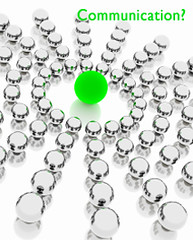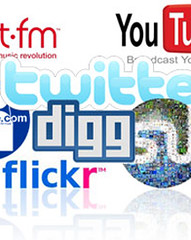Last Thursday, Joanna Blockey, ABC, communication analyst for Southwest Gas Corporation, help put the crossover impact of external and internal communication into perspective as a guest speaker in my Writing For Public Relations class at the University of Nevada, Las Vegas.
While Southwest Gas Corporation has a well-defined program, she pointed out that many companies do not. Some employers still believe that "providing a paycheck" is the company’s only obligation to employees.
“We communicate to approximately 3,200 employees and retirees at Southwest Gas Corporation,” said Blockey. “It would be a mistake to discount them because they are one of our most important publics. Every day, employees go home with a message about the company.”
And then what happens? They talk to friends and family.
Considering some studies place the average person’s number of friends somewhere between 25 and 35, one internal impression about a company can travel considerable distance. At Southwest Gas Corporation for instance, 3,200 employees and retirees could deliver 96,000 impressions about the company. If these friends pass that impression on to even half of their friends, the impression count suddenly reaches 1.5 million people. It doesn’t end there nor does it consider the number of employees who communicate online.
It didn’t seem like it in January, but Yahoo has learned this lesson the hard way. More than one employee has made their layoff public. This communication, which started with 87 connections on Twitter, has since circled the globe and been picked up by the media. That's just one person.
It's something we alluded to back in Jaunary. Employees don’t like the uncertainty created at Yahoo, a message reinforced by Jerry Yang, chief executive, when he botched the balance between being empathetic for the 1,000 employees to be laid off, which started last week, and being bullish on streamlining the company for non-internal shareholders.
Add up employee impressions alone and you'll discover Yahoo is struggling against the weight of more than 3 million low morale impressions per day, which doesn’t even count that some employees have hundreds or thousands of connections online. Suddenly, this seems to make the recently added "padded" severance packages, for employees and top executives in the event of an acquisition, not all that comforting. In fact, the idea of a Yahoo buyout doesn’t even seem very comforting to Microsoft employees either.
All communication overlaps, inside and out.
Seattle Times reporter Benjamin Romano recently published part of one Microsoft internal communication sent by Kevin Johnson, president of the platform and services division at Microsoft.
"While some overlap is expected in any combination of this size," it said, "we should remember that Microsoft is a growth company that has hired over 20,000 people since 2005, and we would look to place talented employees throughout the company as a whole."
It then when on to shed light on just how important advertising has become to Microsoft executives: "Respect for both the creative and analytical aspects of advertising is core to both companies, along with recognition that advertising is an industry that represents opportunity and growth."
The full communication seemed to have several purposes. In addition to fending off growing concerns that a Yahoo acquisition could lead to Microsoft layoffs, it’s a message to internal Microsoft shareholders (meaning employees). It’s also a message to Yahoo employees (who are also Yahoo shareholders). And, it's carefully written in case it might land someplace else like, um, the Seattle Times.
Communication doesn’t happen in a vacuum.
Watson Wyatt, a global consulting firm, released some key findings to consider about employee communication in its 2007/2008 report: Communication ROI Study
Secrets of Top Performers: How Companies With Highly Effective Employee Communication Differentiate Themselves.
• Effective employee communication is a leading indicator of financial performance.
• Effective employee communication translates into a 15.7 percent increase in the market value of a company.
• Effective employee communication increases employee engagement, which translates into better relationships.
The reasons are simple. There has never been a barrier between internal communication and external communication, except for the delusional beliefs of some executives. Simply put, if you cannot get the employees to buy into the company, then how you can expect customers to buy into its products and services?
People, like some companies, make the same mistakes.
The mistake in attempting to apply spatial barriers onto non-spatial ideas, as if things don't overlap, is not limited to business communication. It's an idea that keeps being transposed onto social media and social networks over and over again.
People attempt to define themselves like companies define themselves. They talk in terms that make the company-individual seem like it is the center of the universe with various social networks hovering around them like little planets, not at all different from the geocentric system debunked by Galileo.
Ergo, social networking is better represented by people orbiting an unknown center. On the Internet, they don't orbit a network but rather pass through networks much like they pass through networks in life. Their orbit takes them through this industry, that industry, work, home, friends, etc. Along the way, they leave little bits of communication.
Sure, I know this may seem terribly philosophical to some, but it’s the truth. Human nature is not all that different than nature, which is why employers need to ask themselves what they are communicating and where that communication will be left as their employees go about their daily lives. And then, where will that communication go from there?
Had Yahoo asked these questions months ago, I bet they would have considered a different communication strategy all together. You think?

While Southwest Gas Corporation has a well-defined program, she pointed out that many companies do not. Some employers still believe that "providing a paycheck" is the company’s only obligation to employees.
“We communicate to approximately 3,200 employees and retirees at Southwest Gas Corporation,” said Blockey. “It would be a mistake to discount them because they are one of our most important publics. Every day, employees go home with a message about the company.”
And then what happens? They talk to friends and family.
Considering some studies place the average person’s number of friends somewhere between 25 and 35, one internal impression about a company can travel considerable distance. At Southwest Gas Corporation for instance, 3,200 employees and retirees could deliver 96,000 impressions about the company. If these friends pass that impression on to even half of their friends, the impression count suddenly reaches 1.5 million people. It doesn’t end there nor does it consider the number of employees who communicate online.
It didn’t seem like it in January, but Yahoo has learned this lesson the hard way. More than one employee has made their layoff public. This communication, which started with 87 connections on Twitter, has since circled the globe and been picked up by the media. That's just one person.
It's something we alluded to back in Jaunary. Employees don’t like the uncertainty created at Yahoo, a message reinforced by Jerry Yang, chief executive, when he botched the balance between being empathetic for the 1,000 employees to be laid off, which started last week, and being bullish on streamlining the company for non-internal shareholders.
Add up employee impressions alone and you'll discover Yahoo is struggling against the weight of more than 3 million low morale impressions per day, which doesn’t even count that some employees have hundreds or thousands of connections online. Suddenly, this seems to make the recently added "padded" severance packages, for employees and top executives in the event of an acquisition, not all that comforting. In fact, the idea of a Yahoo buyout doesn’t even seem very comforting to Microsoft employees either.
All communication overlaps, inside and out.
Seattle Times reporter Benjamin Romano recently published part of one Microsoft internal communication sent by Kevin Johnson, president of the platform and services division at Microsoft.
"While some overlap is expected in any combination of this size," it said, "we should remember that Microsoft is a growth company that has hired over 20,000 people since 2005, and we would look to place talented employees throughout the company as a whole."
It then when on to shed light on just how important advertising has become to Microsoft executives: "Respect for both the creative and analytical aspects of advertising is core to both companies, along with recognition that advertising is an industry that represents opportunity and growth."
The full communication seemed to have several purposes. In addition to fending off growing concerns that a Yahoo acquisition could lead to Microsoft layoffs, it’s a message to internal Microsoft shareholders (meaning employees). It’s also a message to Yahoo employees (who are also Yahoo shareholders). And, it's carefully written in case it might land someplace else like, um, the Seattle Times.
Communication doesn’t happen in a vacuum.
Watson Wyatt, a global consulting firm, released some key findings to consider about employee communication in its 2007/2008 report: Communication ROI Study
Secrets of Top Performers: How Companies With Highly Effective Employee Communication Differentiate Themselves.
• Effective employee communication is a leading indicator of financial performance.
• Effective employee communication translates into a 15.7 percent increase in the market value of a company.
• Effective employee communication increases employee engagement, which translates into better relationships.
The reasons are simple. There has never been a barrier between internal communication and external communication, except for the delusional beliefs of some executives. Simply put, if you cannot get the employees to buy into the company, then how you can expect customers to buy into its products and services?
People, like some companies, make the same mistakes.
The mistake in attempting to apply spatial barriers onto non-spatial ideas, as if things don't overlap, is not limited to business communication. It's an idea that keeps being transposed onto social media and social networks over and over again.
People attempt to define themselves like companies define themselves. They talk in terms that make the company-individual seem like it is the center of the universe with various social networks hovering around them like little planets, not at all different from the geocentric system debunked by Galileo.
Ergo, social networking is better represented by people orbiting an unknown center. On the Internet, they don't orbit a network but rather pass through networks much like they pass through networks in life. Their orbit takes them through this industry, that industry, work, home, friends, etc. Along the way, they leave little bits of communication.
Sure, I know this may seem terribly philosophical to some, but it’s the truth. Human nature is not all that different than nature, which is why employers need to ask themselves what they are communicating and where that communication will be left as their employees go about their daily lives. And then, where will that communication go from there?
Had Yahoo asked these questions months ago, I bet they would have considered a different communication strategy all together. You think?























